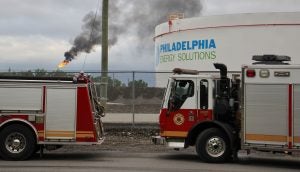Many voices with one mission: Seeking a safer future for PES refinery site
Residents, labor leaders, health and environmental experts, planners and municipal officials gave City Council oversight panels their recommendations.

Signs are held up as a standing room only crowd listens to testimony given by environmental experts, community activists and residents during a community meeting regarding the future of the site of Philadelphia Energy Solutions in August 2019. (Bastiaan Slabbers for WHYY)
South Philadelphia residents, labor leaders, health and environmental experts, planners and municipal officials made recommendations to City Council’s environmental and legislative oversight committees on Friday regarding the future of Philadelphia Energy Solutions’ refinery site.
The 1,300-acre PES complex is currently for sale, as part of the company’s Chapter 11 bankruptcy proceedings. The refinery stopped operating about five months ago, after a catastrophic fire and explosion caused by an old and faulty pipe.
Despite some differences, the various parties attending Friday’s session agreed that no matter what happens next at the site, it has to protect public safety.
“Part of that is, frankly, we don’t want to see hydrofluoric acid on the site, period,” said Philadelphia’s managing director, Brian Abernathy.
About 3,271 pounds of the deadly chemical were released into the atmosphere during the incident in June, according to the federal Chemical Safety and Hazard Investigation Board. A refinery operator evacuated most of the chemical in time to prevent a tragedy.
Residents, experts and labor leaders also pleaded for a ban on hydrofluoric acid. In 2013, the United Steelworkers, which represented 600 workers at the refinery, warned that facilities using HF don’t have enough safety measures in place.
“Hydrofluoric acid in a refinery is an octane accelerant. That’s what it does, it increases the octane of the product. There are alternatives,” said Anthony Wigglesworth, executive director of the Philadelphia Area Labor Management Committee.
As reported by StateImpact Pennsylvania, about 50 refineries across the country use sulfuric acid instead of HF.
“I think it is unconscionable that any responsible owner coming back to this refinery would reintroduce hydrofluoric acid in the manufacturing process,” said Wigglesworth.
Abernathy told the council committees that he is not sure if the city has the power to ban the chemical, but that it’s being looked into. “We may have some control on regulation and laws,” he said.
A co-chair of the city’s Refinery Advisory Group — which has had six public meetings since the fire and is composed of over 20 members representing the community, academia, business and labor groups — Abernathy also presented a preview of the group’s coming report. Based on what was learned in the process, he said the city should favor and encourage a future for the refinery site that sets public safety as a priority, has a more positive impact on public health and the environment, provides long-term economic benefits to the city and good jobs to its residents, gives surrounding communities ways to engage in a meaningful way, and allows for multiple uses and activities at the site.
Although the city does not have direct power over the future of the refinery location because it is privately owned, Abernathy said it can influence future uses through economic incentives.
On top of exploring ways in which the city can regulate HF and other chemicals, Abernathy said the forthcoming report will recommend that Philadelphia review its emergency response and planning capabilities and its air-monitoring capabilities. Both have been criticized by experts and residents.
Adam Thiel, Philadelphia’s fire commissioner and emergency management director, said he’s already working to improve what he called a “resource-driven gap.”
“We’re already getting the resources to be able to improve our ability to communicate 24/7, 365 both internally to the city government, and with all the state and federal partners that are involved in such an incident, as well as with the community,” Thiel said.
Environmental experts, residents and labor representatives also agreed on the need to review the ongoing remediation process conducted by Evergreen Resources for the refinery’s former owner Sunoco (now Energy Transfer Partners) and overseen by the state Department of Environmental Protection. The goal of that effort to remediate legacy contamination at the site is is to reach site-specific standards compatible with another refinery, but not with cleaner uses.
In its recommendations, the Refinery Advisory Group stipulates that any future uses of the site should improve its environmental impact, plan for climate resiliency, take into account sea level rise, and include landscaping, beautification and public amenities — all of which would require higher remediation standards.
“We know from available public documents that the contamination in the soil and the groundwater is pervasive. It will certainly restrict any future access and use of the property, including refining uses and any other industrial uses,” said John Grady, president of the Philadelphia Industrial Development Corp.
Sunoco has been remediating legacy pollution at the site for 26 years, but it failed to involve the community in its planning process, as required by Pennsylvania’s Land Recycling Program, commonly referred to as Act 2.
Last week, activists took over the first public meeting — set by Evergreen Resources, the Sunoco unit managing the work — in 12 years. Abernathy said that Evergreen agreed to convene a second meeting soon, but that he’s not sure what power the city has to raise the cleanup standards.
“We didn’t do a very good job to make that public involvement happen. Obviously, we still need to do a better job,” he said.
The future owner of the refinery complex will be decided in January in U.S. Bankruptcy Court in Wilmington. Last week, Bankruptcy Judge Kevin Gross recognized Philadelphia residents’ concerns about the future of the site and granted participation of city representatives in the auction process, hoping it would be sufficient on behalf of the people’s interests.
“We do want to use what influence we can to get the best outcome for the city. Exactly what that influence will be is yet to be seen,” Abernathy said.
WHYY is your source for fact-based, in-depth journalism and information. As a nonprofit organization, we rely on financial support from readers like you. Please give today.






